- 1CNRS-IRAP, CNES, Univ. Toulouse, Toulouse, France (jlasue@irap.omp.eu)
- 2U.S. Geological Survey, Flagstaff, Arizona, USA
- 3Université de Lyon, UCBL, ENSL, CNRS, LGL-TPE, Villeurbanne, France
- 4University of Copenhagen, Copenhagen, Denmark
- 5Los Alamos National Laboratory, Los Alamos, New Mexico, USA
Context:
On February 18th 2021, the NASA Perseverance rover landed at Jezero crater, Mars, a 50 km Noachian-aged open-basin lake system located on the western side of the Isidis impact structure. The bottom of the crater indicates the presence of a fluvial delta with associated inlet and outlet valleys and infrared observations from orbit have detected the presence of carbonate, mafic and hydrated minerals [1] Since its arrival at the Octavia E. Butler landing site, the rover explored about 100 meters around it initial landing position and analyzed the local bedrocks surrounding it.
Located on the top of the mast of the Perseverance rover is SuperCam, a multipurpose remote sensing instrument able to acquire high resolution color images, infrared, laser-induced breakdown spectroscopy (LIBS) and Raman spectra, and including also a microphone [2, 3]. The LIBS technique is similar to the one used by ChemCam onboard the Curiosity rover, which has been exploring Gale crater since 2012: a powerful laser pulsed at 1064 nm ablates targets at a distance, inducing a plasma spark, the light of which is analyzed by spectroscopy to determine its elemental composition (e.g. [4]). During such an analysis, spectra obtained from the first several laser shots at each location are contaminated by dust deposited on the surface of the rock targets and these spectra are usually removed from further analysis [5]. These spectra present a very homogeneous composition that is different from those of the underlying targets, and are interpreted to represent the analysis of eolian dust deposited over time on the surface of Mars [6].
In this study, we compare the spectral results obtained with the SuperCam first shots on the targets analyzed at the Octavia E. Butler landing site with the average first shot spectra obtained by ChemCam on the rock targets at Gale Crater to confirm whether the signal corresponds to a global microns-thick eolian dust cover of Mars.
Method:
We have used all the LIBS first shot spectra acquired since the landing of Perseverance. This corresponds to ~106 different spectra processed by denoising, background removal, wavelength calibration, and correction for instrument response. The average spectrum obtained from these data can then be appropriately compared with the average first shot spectrum obtained by ChemCam at Gale crater, which was built over 1500 sols (~ 8500 spectra). There is a 2 orders of magnitude difference between the number of first shots acquired by SuperCam and ChemCam at this time, so we can expect the SuperCam results to be less representative than the ChemCam ones.
Results:
The comparison of the LIBS spectra (Figure 1.) indicate strong similarities in major element compositions The only disparity comes from apparent elevated Mg and Ca lines in the SuperCam signal, which are possibly due to a local contribution. The minor elements, such as H, Li, Mn, Cr, also present peaks with intensities similar to the ones detected on the ChemCam spectrum, indicating a similar level of hydration and minor elements contents of the dust fraction at Jezero and at Gale. While the rocks analyzed by SuperCam at Jezero crater appear visually to be less covered by dust than the ones seen at Gale crater, our analysis indicates that the rocks studied at Jezero remain covered by a thin layer of homogeneous material similar in composition to the eolian deposited dust. This result is consistent with a global mixing of the eolian dust cover on Mars at the micron scale, or possibly a single origin for the eolian dust on Mars as described in previous studies (e.g. [7, 8]).
Conclusion:
The average of the first LIBS shot spectra acquired by SuperCam at Jezero crater compare very well with the average spectrum of ChemCam’s first shots at Gale crater. The intensity of the emission lines in the two spectra are very similar indicating the probable global mixing of the dust deposited all over the surface of Mars.
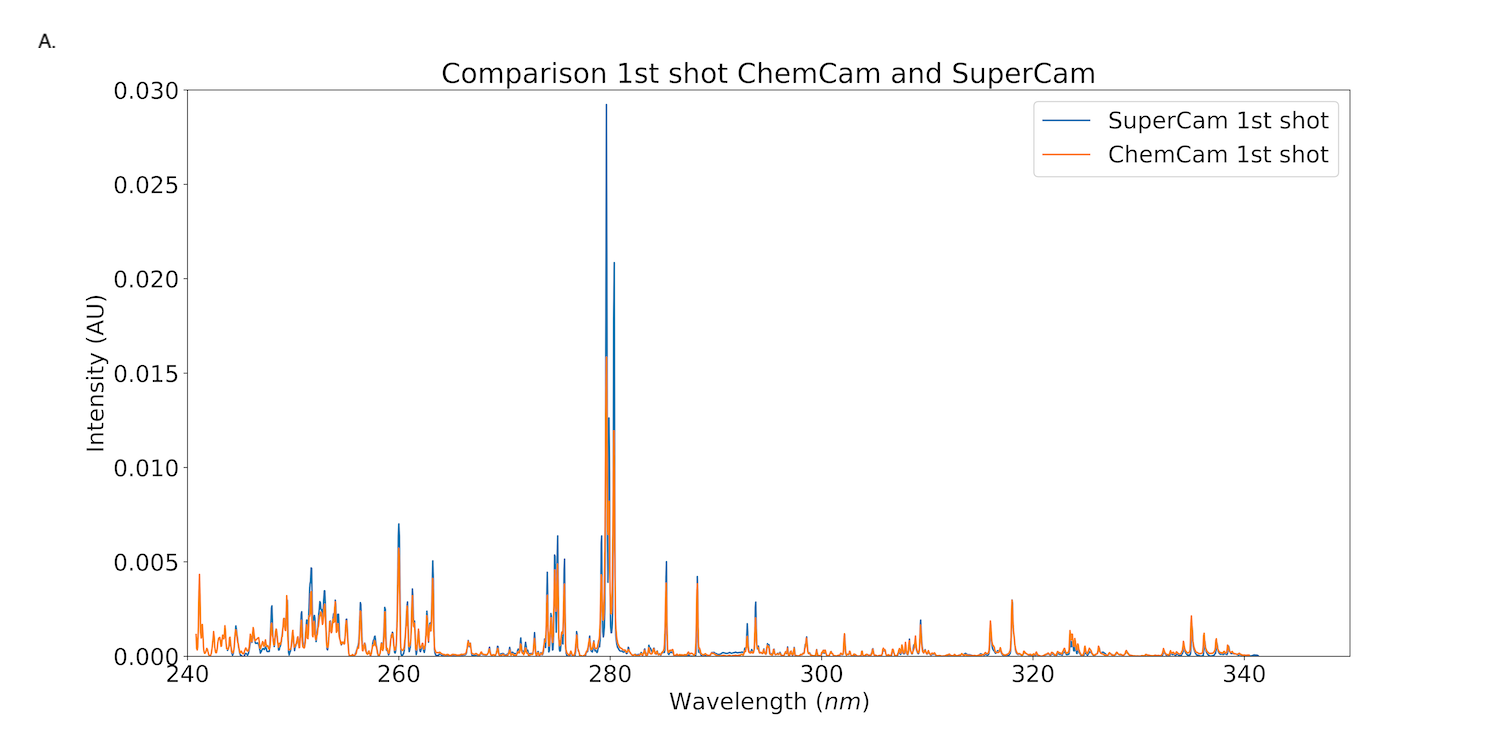
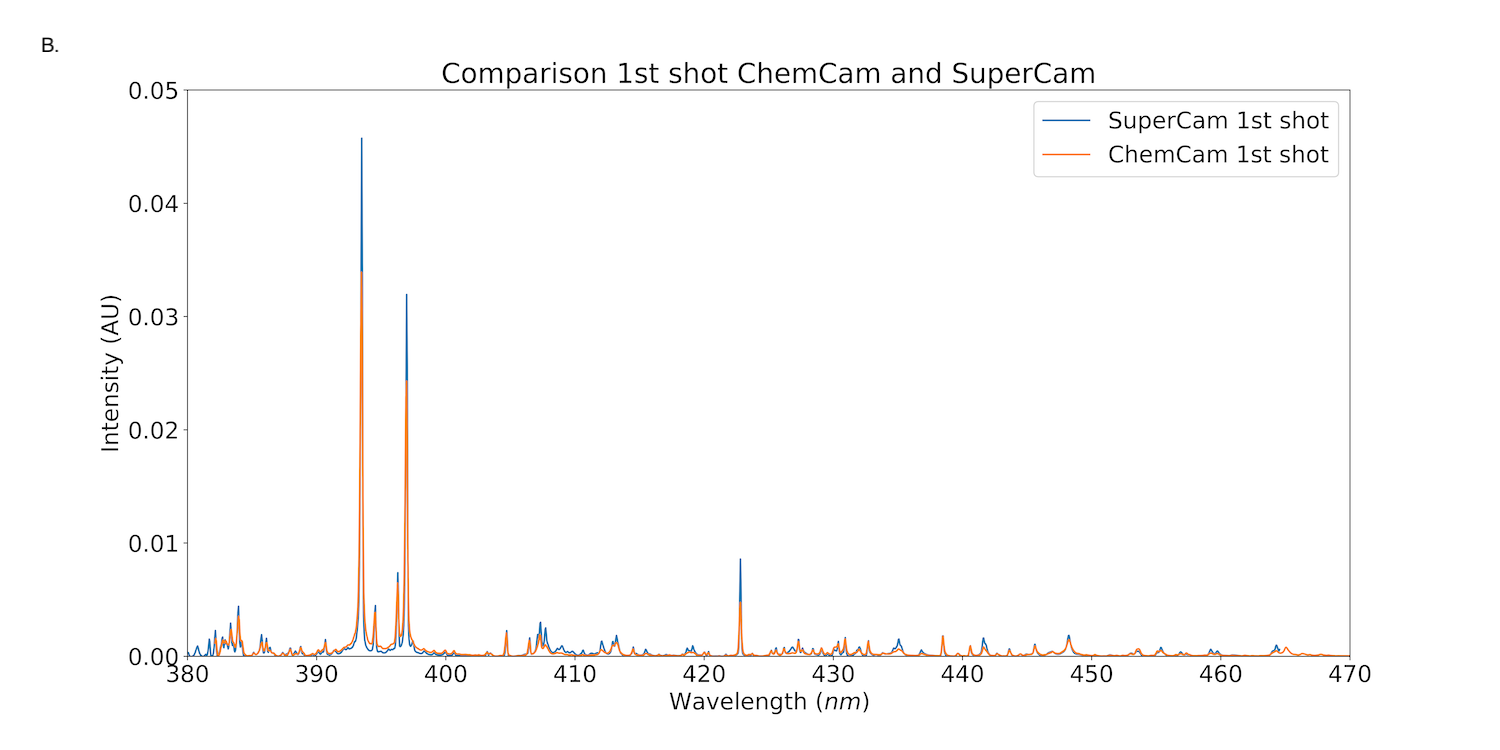
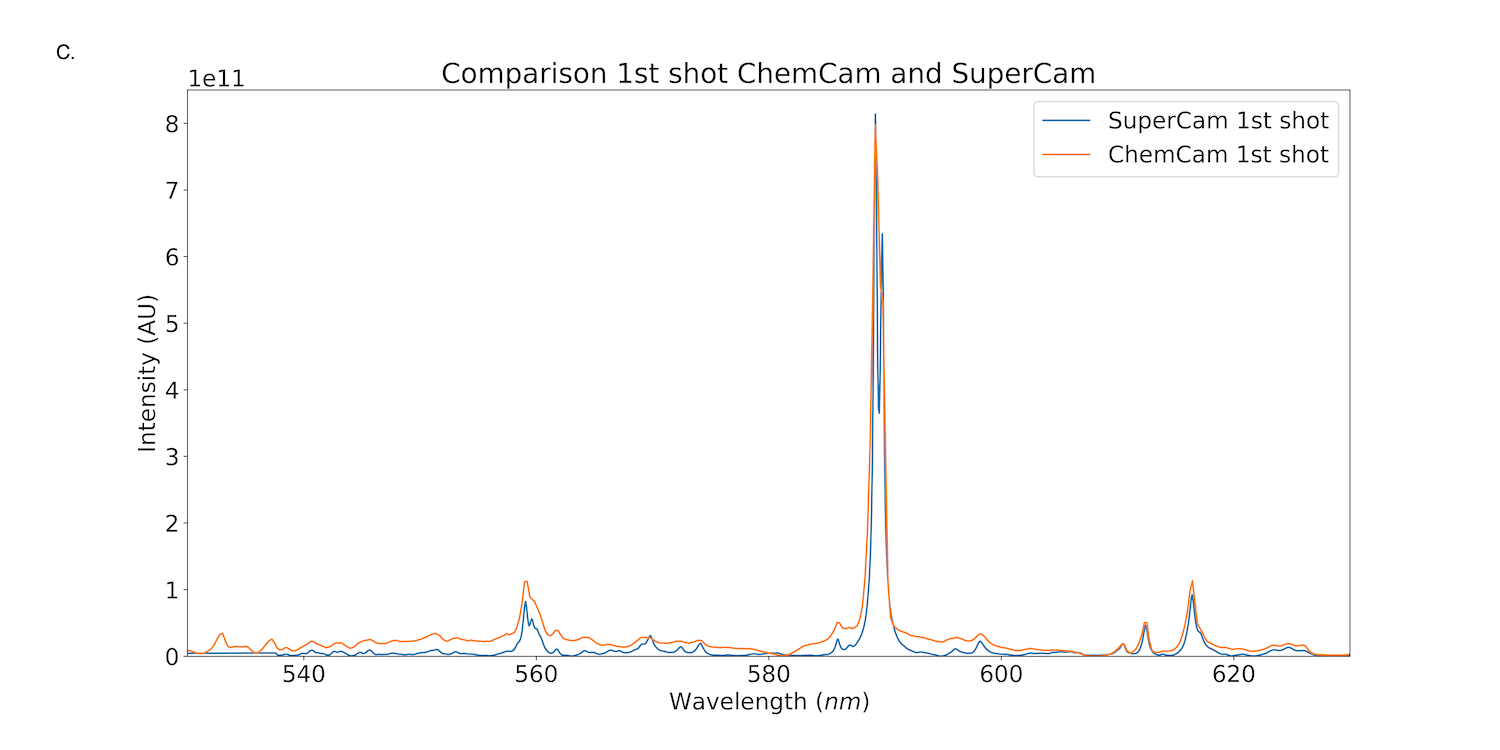
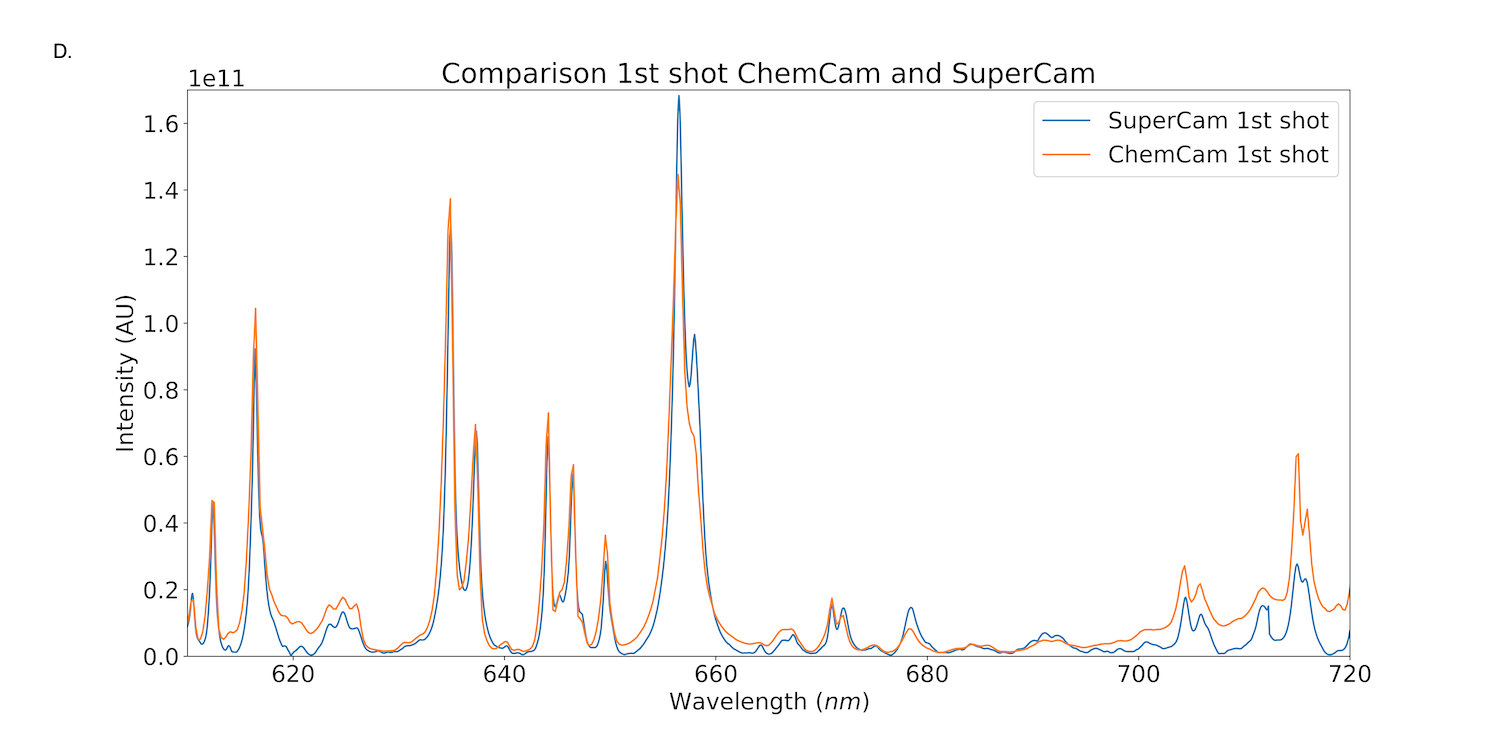
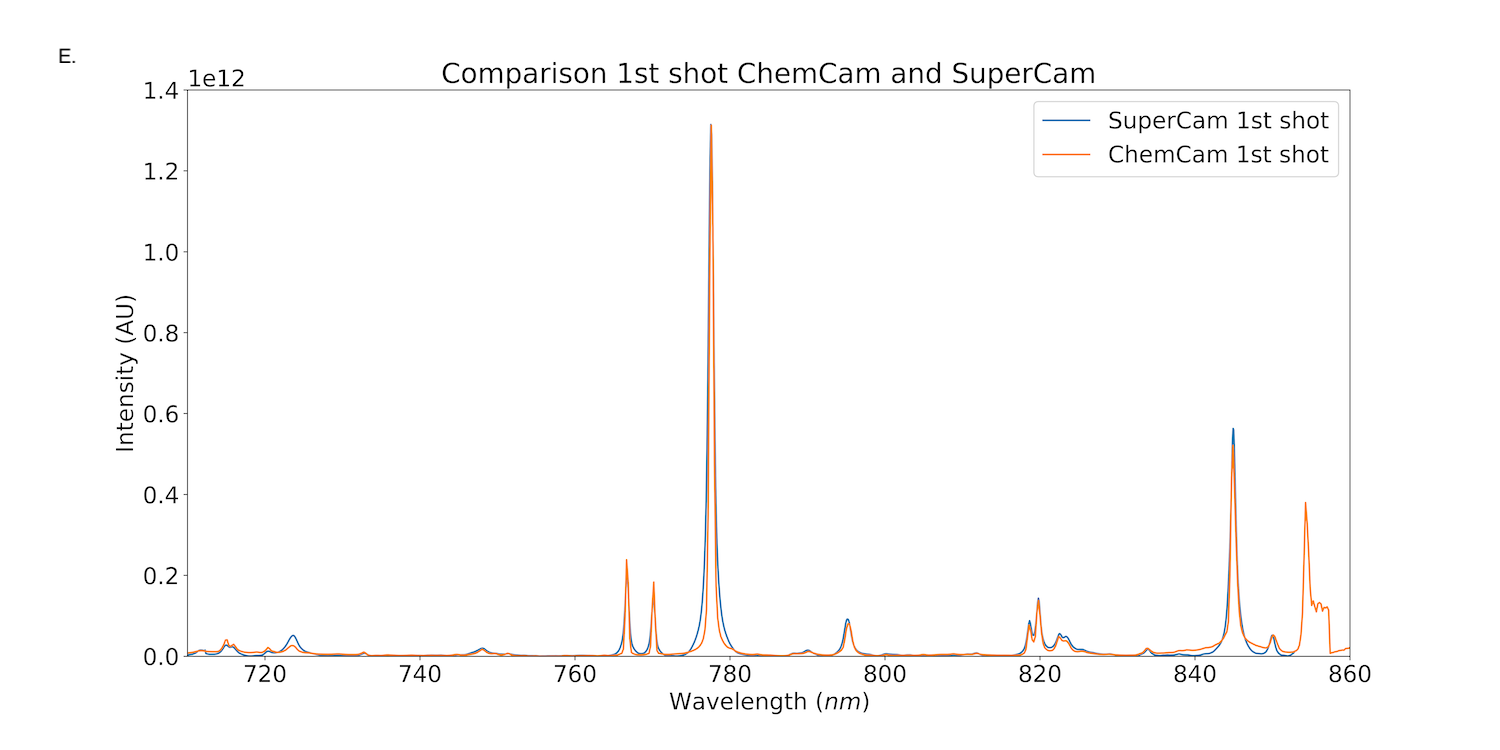
Figure 1: Comparison of average first shots LIBS spectra of ChemCam at Gale Crater ([6] in red) and average first shots LIBS spectra of SuperCam at Jezero Crater (in blue). A) UV range, B) blue-violet range, C) green range D) orange range E) red range.
Acknowledgements:
The Perseverance rover and the SuperCam instrument were funded by NASA, CNES and LANL.
References:
[1] Stack, K. M., et al. (2020) Space Science Reviews, 216(8), 1-47. [2] Maurice, S., et al. (2021) Space Science Reviews, 217(3), 1-108. [3] Wiens, R. C., et al. (2021) Space Science Reviews, 217(1), 1-87. [4] Maurice, S., et al. (2016) Journal of Analytical Atomic Spectrometry, 31(4), 863-889. [5] Clegg, S. M., et al. (2017) Spectrochimica Acta Part B: Atomic Spectroscopy, 129, 64-85. [6] Lasue, J., et al. (2018) Geophysical Research Letters, 45(20), 10-968. [7] Berger, J. A., et al. (2016). Geophysical Research Letters, 43(1), 67-75. [8] Ojha, L., et al. (2018) Nature communications, 9(1), 1-7.
How to cite: Lasue, J., Meslin, P.-Y., Cousin, A., Forni, O., Anderson, R., Dehouck, E., Frydenvang, J., Gasnault, O., Rapin, W., Pilleri, P., Clegg, S., and Wiens, R.: Comparing SuperCam first shots at Jezero with ChemCam eolian dust analysis at Gale, Europlanet Science Congress 2021, online, 13–24 Sep 2021, EPSC2021-254, https://doi.org/10.5194/epsc2021-254, 2021.

